MyBatis
环境:
- JDK1.8
- MySQL5.7
- maven3.6.1
- IDEA
回顾:
- JDBC
- MySQL
- java基础
- Maven
- Junit
框架:配置文件的,最好的方式:看官方文档
1 简介
1.1 什么是MyBatis

- MyBatis 是一款优秀的持久层框架
- 它支持自定义 SQL、存储过程以及高级映射。
- MyBatis 免除了几乎所有的 JDBC 代码以及设置参数和获取结果集
- MyBatis 可以通过简单的 XML 或注解来配置和映射原始类型、接口和 Java POJO(Plain Old Java Objects,普通老式 Java 对象)为数据库中的记录。
- MyBatis 本是apache的一个开源项目iBatis, 2010年这个项目由apache software foundation 迁移到了google code,并且改名为MyBatis 。
- 2013年11月迁移到Github。
如何获得MyBatis?
- Maven仓库
<!-- https://mvnrepository.com/artifact/org.mybatis/mybatis -->
<dependency>
<groupId>org.mybatis</groupId>
<artifactId>mybatis</artifactId>
<version>3.5.7</version>
</dependency>- GitHub:https://github.com/mybatis/mybatis-3/releases
- 中文文档:https://mybatis.org/mybatis-3/zh/index.html
1.2 持久化
数据持久化
- 持久化就是将程序的数据在持久状态和瞬时状态转化的过程
- 内存:断点即失
- 数据库(jdbc),io文件持久化
- 生活:冷藏、罐头。 为什么需要持久化?
- 有一些对象,不能让它丢掉
- 内存太贵了
1.3 持久层
Dao层,Service层,Controller层…
- 完成持久化工作的代码块
- 层界限非常明显
1.4 为什么需要MyBatis?
- 帮助程序员将数据存入到数据库中
- 方便
- 传统的JDBC代码太复杂了,简化,框架自动化
- 不用MyBatis也可以,更容易上手。技术没有高低之分
- 优点
- 简单易学
- 灵活
- 解除sql与程序代码的耦合,提高了可维护性
- 提供映射标签,支持对象与数据库的orm字段关系映射
- 提供对象关系映射标签,支持对象关系组建维护
- 提供xml标签,支持编写动态sql。
最重要的一点:使用的人多!
2 第一个MyBatis程序
思路:搭建环境 --> 导入MyBatis -->编写代码 --> 测试
2.1 搭建环境
搭建数据库
CREATE DATABASE `mybatis`;
USE `mybatis`;
CREATE TABLE `user` (
`id` INT(20) NOT NULL,
`name` VARCHAR(20) DEFAULT NULL,
`pwd` VARCHAR(20) DEFAULT NULL,
PRIMARY KEY(`id`)
)ENGINE=INNODB DEFAULT CHARSET=utf8;
INSERT INTO `user`(`id`, `name`, `pwd`) VALUES
(1, '狂神', '123456'),
(2, '张三', '123456'),
(3, '李四', '123890');新建项目 1. 新建一个普通的maven项目 2. 删除src目录 3. 导入maven依赖
<dependencies>
<!-- https://mvnrepository.com/artifact/org.mybatis/mybatis -->
<dependency>
<groupId>org.mybatis</groupId>
<artifactId>mybatis</artifactId>
<version>3.5.7</version>
</dependency>
<dependency>
<groupId>mysql</groupId>
<artifactId>mysql-connector-java</artifactId>
<version>8.0.25</version>
</dependency>
<dependency>
<groupId>junit</groupId>
<artifactId>junit</artifactId>
<version>4.13.2</version>
<scope>test</scope>
</dependency>
</dependencies>2.2 创建一个模块
- 编写MyBatis核心配置文件
<?xml version="1.0" encoding="UTF-8" ?>
<!DOCTYPE configuration
PUBLIC "-//mybatis.org//DTD Config 3.0//EN"
"http://mybatis.org/dtd/mybatis-3-config.dtd">
<!-- configuration核心配置文件 -->
<configuration>
<environments default="development">
<environment id="development">
<transactionManager type="JDBC"/>
<dataSource type="POOLED">
<property name="driver" value="com.mysql.cj.jdbc.Driver"/>
<property name="url" value="jdbc:mysql://localhost:3306/mybatis?characterEncoding=utf8&serverTimezone=GMT%2B8&useSSL=true&useUnicode=true"/>
<property name="username" value="root"/>
<property name="password" value="123456"/>
</dataSource>
</environment>
</environments>
</configuration>- 编写MyBatis工具类
package cn.tedu.util;
import org.apache.ibatis.io.Resources;
import org.apache.ibatis.session.SqlSession;
import org.apache.ibatis.session.SqlSessionFactory;
import org.apache.ibatis.session.SqlSessionFactoryBuilder;
import java.io.IOException;
import java.io.InputStream;
/**
* @ClassName MybatisUtils
* @Description sqlSessionFactory --> sqlSession
* @Author keke
* @Time 2021/5/28 21:30
* @Version 1.0
*/
public class MybatisUtils {
private static SqlSessionFactory sqlSessionFactory;
static {
try {
// 使用MyBatis第一步:获取SqlSessionFactory对象
String resource = "mybatis-config.xml";
InputStream inputStream = Resources.getResourceAsStream(resource);
sqlSessionFactory = new SqlSessionFactoryBuilder().build(inputStream);
} catch (IOException e) {
e.printStackTrace();
}
}
/**
* 既然有了 SqlSessionFactory,顾名思义,我们可以从中获得 SqlSession 的实例。
* SqlSession 提供了在数据库执行 SQL 命令所需的所有方法。
* @return
*/
public static SqlSession getSqlSession(){
return sqlSessionFactory.openSession();
}
}2.3 编写代码
- 实体类
package cn.tedu.pojo;
/**
* @ClassName User
* @Description
* @Author keke
* @Time 2021/5/28 21:45
* @Version 1.0
*/
public class User {
private int id;
private String name;
private String pwd;
public User() {
}
public User(int id, String name, String pwd) {
this.id = id;
this.name = name;
this.pwd = pwd;
}
public int getId() {
return id;
}
public void setId(int id) {
this.id = id;
}
public String getName() {
return name;
}
public void setName(String name) {
this.name = name;
}
public String getPwd() {
return pwd;
}
public void setPwd(String pwd) {
this.pwd = pwd;
}
@Override
public String toString() {
return "User{" +
"id=" + id +
", name='" + name + '\'' +
", pwd='" + pwd + '\'' +
'}';
}
}- Dao接口
package cn.tedu.dao;
import cn.tedu.pojo.User;
import java.util.List;
/**
* @ClassName UserDao
* @Description
* @Author keke
* @Time 2021/5/28 21:51
* @Version 1.0
*/
public interface UserDao {
List<User> getUserList();
}- 接口实现类由原来的UserDaoImpl转变为一个Mapper配置文件
<?xml version="1.0" encoding="UTF-8" ?>
<!DOCTYPE mapper
PUBLIC "-//mybatis.org//DTD Mapper 3.0//EN"
"http://mybatis.org/dtd/mybatis-3-mapper.dtd">
<!-- namespace绑定一个对应的Dao/Mapper接口 -->
<mapper namespace="cn.tedu.dao.UserDao">
<!-- select 查询语句 -->
<select id="getUserList" resultType="cn.tedu.pojo.User">
select id, name, pwd from mybatis.user
</select>
</mapper>2.4 测试
注意点: org.apache.ibatis.binding.BindingException: Type interface cn.tedu.dao.UserDao is not known to the MapperRegistry.
MapperRegistry是什么 核心配置文件注册mapper
- Junit测试
package cn.tedu.dao;
import cn.tedu.pojo.User;
import cn.tedu.util.MybatisUtils;
import org.apache.ibatis.session.SqlSession;
import org.junit.Test;
import java.util.List;
/**
* @ClassName UserDaoTests
* @Description
* @Author keke
* @Time 2021/5/28 22:07
* @Version 1.0
*/
public class UserDaoTests {
@Test
public void test(){
// 1.获得SqlSession对象
SqlSession sqlSession = MybatisUtils.getSqlSession();
// 方式一:getMapper
UserDao userDao = sqlSession.getMapper(UserDao.class);
List<User> userList = userDao.getUserList();
for (User user : userList) {
System.out.println(user);
}
sqlSession.close();
}
}遇到的问题
- 配置文件没有注册
- 绑定接口错误
<!-- 每一个Mapper.xml都需要在MyBatis核心配置文件中注册 -->
<mappers>
<mapper resource="cn/tedu/dao/UserMapper.xml" />
</mappers>- 方法名不对
- 返回类型不对
- maven导出资源
<build>
<resources>
<resource>
<directory>src/main/resources</directory>
<includes>
<include>**/*.properties</include>
<include>**/*.xml</include>
</includes>
<filtering>true</filtering>
</resource>
<resource>
<directory>src/main/java</directory>
<includes>
<include>**/*.properties</include>
<include>**/*.xml</include>
</includes>
<filtering>true</filtering>
</resource>
</resources>
</build>3 CRUD
3.1 namespace
namespace中的包名要和Dao/Mapper接口的包名一致
3.2 select
选择,查询语句
- id:就是对应的namespace中的方法名;
- resultType:SQL语句执行的返回值
- parameterType:参数类型
- 编写接口
/**
* 根据id查询用户
* @param id
* @return
*/
User getUserById(int id);- 编写对应的Mapper中的SQL语句
<select id="getUserById" resultType="cn.tedu.pojo.User">
select id, name, pwd from mybatis.user where id = #{id};
</select>- 测试
/**
* 增删改需要提交事务
*/
@Test
public void addUser(){
SqlSession sqlSession = MybatisUtils.getSqlSession();
UserDao mapper = sqlSession.getMapper(UserDao.class);
int res = mapper.addUser(new User(4, "哈哈", "123333"));
if (res > 0){
System.out.println("插入成功");
}
// 提交事务
sqlSession.commit();
sqlSession.close();
}3.3 insert
<!-- 对象中的属性,可以直接取出来-->
<insert id="addUser" parameterType="cn.tedu.pojo.User">
insert into mybatis.user (id, name, pwd)
values (#{id}, #{name}, #{pwd});
</insert>3.4 upate
<update id="updateUser" parameterType="cn.tedu.pojo.User">
update mybatis.user
set name = #{name},
pwd = #{pwd}
where id = #{id};
</update>3.5 delete
<delete id="deleteUser">
delete
from mybatis.user
where id = #{id};
</delete>注意点:
- 增删改需要提交事务!
3.6 分析错误
- 标签不要匹配错误
- resource绑定mapper需要使用路径
- 程序配置文件必须符合规范
- NullPointException,没有注册到资源
- 输出的xml文件中存在中文乱码问题
- maven资源导出问题
3.7 万能Map
假设我们的实体类或者数据库中的表,字段或者参数过多,我们应当考虑使用Map
/**
* 万能map
* @param map
* @return
*/
int addUser2(Map<String, Object> map);<!-- 传递map的key -->
<insert id="addUser2" parameterType="map">
insert into mybatis.user (id, name, pwd)
values (#{userid}, #{username}, #{password});
</insert>@Test
public void addUser2(){
SqlSession sqlSession = MybatisUtils.getSqlSession();
UserDao mapper = sqlSession.getMapper(UserDao.class);
Map<String, Object> map = new HashMap<>();
map.put("userid", 5);
map.put("username", "Hello");
map.put("password", "222333");
int res = mapper.addUser2(map);
if (res > 0){
System.out.println("插入成功");
}
// 提交事务
sqlSession.commit();
sqlSession.close();
}Map传递参数,直接在SQL中取出key即可【parameterType=“map”】 对象传递参数,直接在SQL中取对象的属性即可【parameterType=“Object”】 只有一个基本类型的情况下,可以直接在SQL中取到 多个参数用Map,或者注解
3.8 思考题
模糊查询怎么写?
- java代码执行的时候,传递通配符%value%
List<User> users = mapper.getUserLike("%李%");- 在SQL拼接中使用通配符
select id, name, pwd from mybatis.user where name like "%"#{value}"%";4 配置解析
4.1 核心配置文件
- mybatis-config.xml
- MyBatis 的配置文件包含了会深深影响 MyBatis 行为的设置和属性信息。
configuration(配置)
properties(属性)
settings(设置)
typeAliases(类型别名)
typeHandlers(类型处理器)
objectFactory(对象工厂)
plugins(插件)
environments(环境配置)
environment(环境变量)
transactionManager(事务管理器)
dataSource(数据源)
databaseIdProvider(数据库厂商标识)
mappers(映射器)4.2 环境配置(environments)
- MyBatis 可以配置成适应多种环境。
- 不过要记住:尽管可以配置多个环境,但每个 SqlSessionFactory 实例只能选择一种环境。 学会使用配置多套运行环境 MyBatis默认是事务过滤器就是JDBC,连接池:POOLED
4.3 属性(properties)
我们可以通过properties属性来实现引用配置文件 这些属性可以在外部进行配置,并可以进行动态替换。你既可以在典型的 Java 属性文件中配置这些属性,也可以在 properties 元素的子元素中设置【db.properties】

编写一个配置文件 db.properties
driver=com.mysql.cj.jdbc.Driver
url=jdbc:mysql://localhost:3306/mybatis?characterEncoding=utf8&serverTimezone=GMT%2B8&useSSL=true&useUnicode=true
username=root
password=123456在核心配置文件中引入
<!-- 引入外部配置文件 -->
<properties resource="db.properties">
<property name="username" value="root"/>
<property name="password" value="111111"/>
</properties>- 可以直接引入外部文件
- 可以在其中增加一些属性配置
- 如果两个文件有同一个字段,优先使用外部配置文件
4.4 类型别名(typeAliases)
- 类型别名可为 Java 类型设置一个缩写名字。
- 意在降低冗余的全限定类名书写。
<!-- 可以给实体类起别名 -->
<typeAliases>
<typeAlias type="cn.tedu.pojo.User" alias="User"/>
</typeAliases>也可以指定一个包名,MyBatis 会在包名下面搜索需要的 Java Bean 扫描实体类的包,它的默认别名就为这个类的类名,首字母小写
<!-- 可以给实体类起别名 -->
<typeAliases>
<package name="cn.tedu.pojo"/>
</typeAliases>在实体类比较少的时候,使用第一种方式 在实体类比较多的时候,使用第二种方式 第一种可以DIY别名,第二种则不行,如果非要改,则在实体类上增加注解
@Alias("user")
public class User{}4.5 设置(settings)
- 这是 MyBatis 中极为重要的调整设置,它们会改变 MyBatis 的运行时行为。 下表描述了设置中各项设置的含义、默认值等。


4.6 其他配置
- typeHandlers(类型处理器)
- objectFactory(对象工厂)
- plugins(插件)
- mybatis-generator-core
- mybatis-plus
- 通用mapper
4.7 映射器(mappers)
MapperRegistry:注册绑定我们的Mapper文件 方式一:
<!-- 每一个Mapper.xml都需要在MyBatis核心配置文件中注册 -->
<mappers>
<mapper resource="cn/tedu/dao/UserMapper.xml" />
</mappers>方式二:使用class文件绑定注册
<!-- 每一个Mapper.xml都需要在MyBatis核心配置文件中注册 -->
<mappers>
<mapper class="cn.tedu.dao.UserMapper" />
</mappers>注意点:
- 接口和它的Mapper配置必须同名
- 接口和它的Mapper配置必须在同一包下 方式三:使用扫描包进行注入绑定
<!-- 每一个Mapper.xml都需要在MyBatis核心配置文件中注册 -->
<mappers>
<package name="cn.tedu.dao"/>
</mappers>注意点:
- 接口和它的Mapper配置必须同名
- 接口和它的Mapper配置必须在同一包下 练习时间:
- 将数据库配置文件外部引入
- 实体类别名
- 保证UserMapper接口和UserMapper .xml改为一致!并且放在同一个包下!
4.8 生命周期和作用域
生命周期和作用域是至关重要的,因为错误的使用会导致非常严重的并发问题
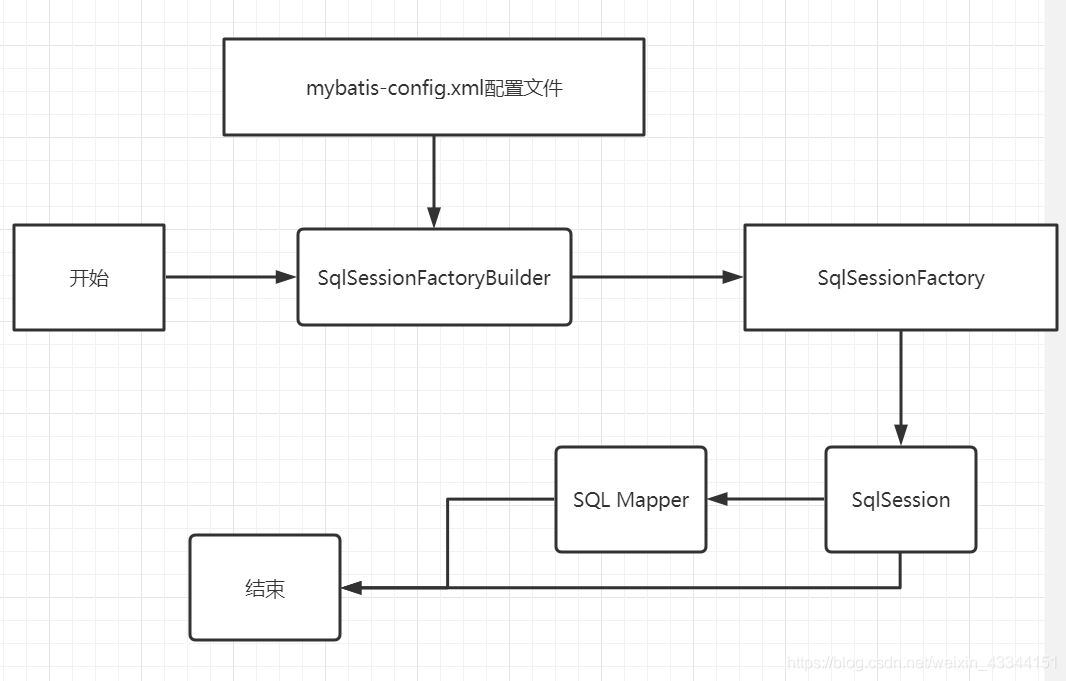
SqlSessionFactoryBuilder
- 一旦创建了SqlSessionFactory,就不再需要它了
- 局部变量 SqlSessionFactory
- 说白了就是可以想象为数据库连接池
- SqlSessionFactory一旦被创建就一个在应用的运行期间一直存在,没有任何理由丢弃它或重新创建另一个实例
- 因此SqlSessionFactory的最佳作用域是应用作用域
- 最简单的就是使用单例模式或者静态单例模式 SqlSession
- 连接到连接池的一个请求
- SqlSession的实例不是线程安全的,因此不能被共享,所以它的最佳作用域是请求或方法作用域
- 用完之后赶紧关闭,否则资源被占用
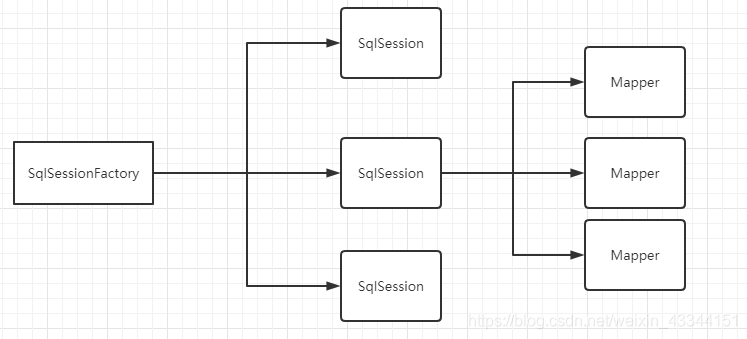
这里面的每一个Mapper,就代表每一个具体的业务
5 解决属性名和字段名不一致的问题
5.1 问题
数据库中的字段
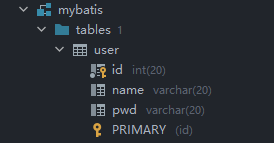
新建一个项目,拷贝之前的,测试实体类字段不一致的情况
package cn.tedu.pojo;
import org.apache.ibatis.type.Alias;
/**
* @ClassName User
* @Description
* @Author keke
* @Time 2021/5/28 21:45
* @Version 1.0
*/
@Alias("user")
public class User {
private int id;
private String name;
private String password;
}测试出现问题

// 类型处理器
// select id, name, pwd from mybatis.user where id = #{id};解决方法:
- 起别名
<select id="getUserById" resultType="user">
select id, name, pwd as password from mybatis.user where id = #{id};
</select>5.2 resultMap
结果集映射
id name pwd
id name password <!-- 结果集映射-->
<resultMap id="UserMap" type="User">
<!--
column:数据库中的字段
property:实体类中的属性
-->
<result column="id" property="id" />
<result column="name" property="name" />
<result column="pwd" property="password" />
</resultMap>
<select id="getUserById" resultMap="UserMap">
select id, name, pwd
from mybatis.user where id = #{id};
</select>resultMap元素是 MyBatis 中最重要最强大的元素。ResultMap的设计思想是,对简单的语句做到零配置,对于复杂一点的语句,只需要描述语句之间的关系就行了ResultMap的优秀之处在于,你完全可以不用显式地配置它们。- 如果世界总是这么简单就好了
6 日志
6.1 日志工厂
如果一个数据库操作,出现了异常,我们需要排错,日志就是最好的助手 曾经:sout debug 现在:日志工厂

- SLF4J
- LOG4J 【掌握】
- LOG4J2
- JDK_LOGGING
- COMMONS_LOGGING
- STDOUT_LOGGING 【掌握】
- NO_LOGGING 在mybatis中具体使用哪一个日志实现,在设置中设定 STDOUT_LOGGING标准日志输出 在mybatis配置文件中配置我们的日志
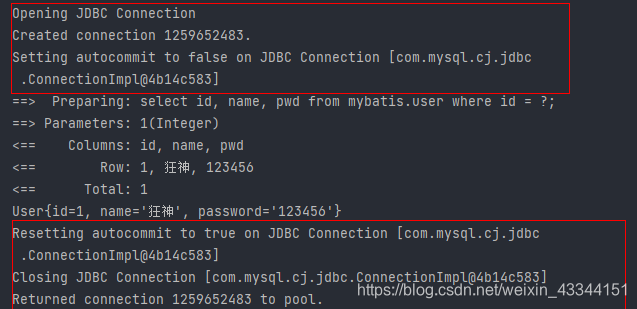
6.2 Log4J
什么是Log4J?
- Log4J是Apache的一个开源项目,通过使用Log4J,我们可以控制日志信息输送的目的地是控制台,文件,GUI组件
- 我们也可以控制每一条日志的输出格式
- 通过定义每一条日志信息的级别,我们能够更加细致地控制日志的生成过程
- 通过一个配置文件来灵活地进行配置,而不需要修改应用的代码。
- 先导入Log4J的包
<!-- https://mvnrepository.com/artifact/log4j/log4j -->
<dependency>
<groupId>log4j</groupId>
<artifactId>log4j</artifactId>
<version>1.2.17</version>
</dependency>- log4j.properties
# 将等级为DEBUG的日志信息输出到console和fiLe这两个目的地,console和fiLe的定义在下面的代码
log4j.rootLogger=DEBUG,console,file
# 控制台输出的相关没置
log4j.appender.console = org.apache.log4j.ConsoleAppender
log4j.appender.console.Target = System.out
log4j.appender.console.Threshold=DEBUG
log4j.appender.console.layout = org.apache.log4j.PatternLayout
log4j.appender.console.layout.conversionPattern=[%c ]-%m%n
# 文件输出的相关没置
log4j.appender.file = org.apache.log4j.RollingFileAppender
log4j.appender.file.File=./log/tedu.log
log4j.appender.file.MaxFileSize=10mb
log4j.appender.file.Threshold=DEBUG
log4j.appender.file.layout=org.apache.log4j.PatternLayout
log4j.appender.file.layout.conversionPattern=[%p][%d{yy-M-dd}][%c]%m%n
# 日志输出级别
log4j.logger.org.mybatis=DEBUG
log4j.logger.java.sql=DEBUG
log4j.logger.java.sql.Statement=DEBUG
log4j.logger.java.sq1.ResultSet=DEBUG
log4j.logger.java.sql.PreparedStatement=DEBUG- 配置Log4J为日志的实现
<settings>
<setting name="logImpl" value="LOG4J"/>
</settings>- Log4J的使用,直接测试刚才的查询

简单使用
- 在要使用Log4J的类中,导入包import org.apache.log4j.Logger;
- 日志对象,参数为当前类的class
private static Logger logger = Logger.getLogger(UserMapperTests.class);- 日志级别
logger.info("info:进入了testLog4j");
logger.debug("debug:进入了testLog4j");
logger.error("error:进入了testLog4j");7 分页
思考:为什么要分页
- 减少数据的创立了
7.1 使用Limit分页
语法:select * from user limit startIndex, pageSize;
select * from user limit 3; # [0, n]使用mybatis实现分页,核心SQL
- 接口
/**
* 分页实现查询
* @param map
* @return
*/
List<User> getUserByLimit(Map<String, Integer> map);- Mapper.xml
<!--分页-->
<select id="getUserByLimit" resultMap="UserMap"
parameterType="map" resultType="user">
select * from mybatis.user limit #{startIndex}, #{pageSize};
</select>- 测试
@Test
public void getUserByLimit(){
SqlSession sqlSession = MybatisUtils.getSqlSession();
UserMapper mapper = sqlSession.getMapper(UserMapper.class);
Map<String, Integer> map = new HashMap<>();
map.put("startIndex", 0);
map.put("pageSize", 2);
List<User> userList = mapper.getUserByLimit(map);
userList.forEach(System.out::println);
sqlSession.close();
}7.2 RowBounds分页
不再使用SQL实现分页
- 接口
/**
* 分页实现查询2
* @return
*/
List<User> getUserByRowBounds();- Mapper.xml
<!--分页-->
<select id="getUserByRowBounds" resultMap="UserMap" resultType="user">
select * from mybatis.user;
</select>- 测试
@Test
public void getUserByRowBounds(){
SqlSession sqlSession = MybatisUtils.getSqlSession();
// RowBounds实现
RowBounds rowBounds = new RowBounds(1, 2);
// 通过Java代码层面实现分页
List<User> userList = sqlSession.selectList("cn.tedu.dao.UserMapper.getUserByRowBounds", null, rowBounds);
for (User user : userList) {
System.out.println(user);
}
sqlSession.close();
}7.3 分页插件
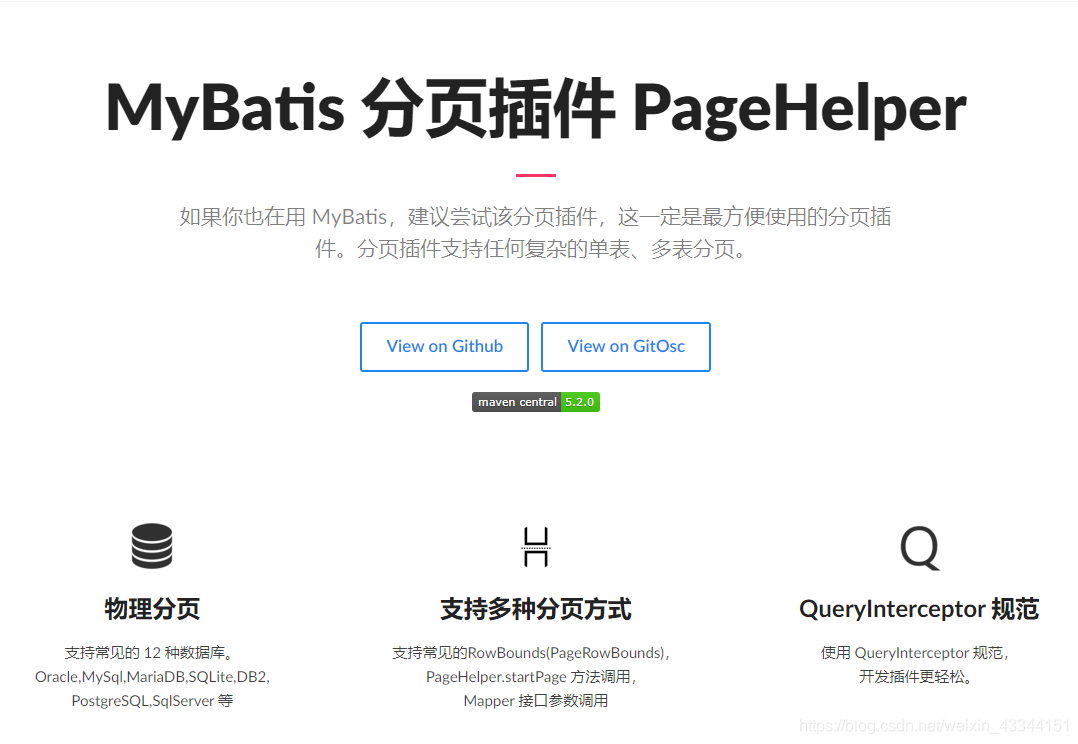
了解即可,万一以后公司的架构师,说要使用,你需要知道它是什么东西
8 使用注解开发
8.1 面向接口编程
- 大家之前都学过面向对象编程,也学习过接口,但在真正的开发中,很多时候我们会选择面向接口编程
- 根本原因∶解耦,可拓展,提高复用,分层开发中,上层不用管具体的实现,大家都遵守共同的标准,使得开发变得容易,规范性更好
- 在一个面向对象的系统中,系统的各种功能是由许许多多的不同对象协作完成的。在这种情况下,各个对象内部是如何实现自己的.对系统设计人员来讲就不那么重要了;
- 而各个对象之间的协作关系则成为系统设计的关键。小到不同类之间的通信,大到各模块之间的交互,在系统设计之初都是要着重考虑的,这也是系统设计的主要工作内容。面向接口编程就是指按照这种思想来编程。
关于接口的理解
- 接口从更深层次的理解,应是定义(规范,约束)与实现(名实分离的原则)的分离。
- 接口的本身反映了系统设计人员对系统的抽象理解。
- 接口应有两类;
- 第一类是对一个个体的抽象,它可对应为一个抽象体(abstract class);
- 第二类是对一个个体某一方面的抽象,即形成一个抽象面(interface) ;
- 一个体有可能有多个抽象面。抽象体与抽象面是有区别的。
三个面向区别
- 面向对象是指,我们考虑问题时,以对象为单位,考虑它的属性及方法.
- 面向过程是指,我们考虑问题时,以一个具体的流程(事务过程)为单位,考虑它的实现.
- 接口设计与非接口设计是针对复用技术而言的,与面向对象(过程)不是一个问题.更多的体现就是对系统整体的架构
8.2 使用注解开发
- 注解在接口上实现
@Select("select * from user")
List<User> getUsers();- 需要在核心配置文件中绑定接口
<!--绑定接口-->
<mappers>
<mapper class="cn.tedu.dao.UserMapper" />
</mappers>- 测试
@Test
public void test(){
SqlSession sqlSession = MybatisUtils.getSqlSession();
// 底层主要应用反射
UserMapper mapper = sqlSession.getMapper(UserMapper.class);
List<User> users = mapper.getUsers();
users.forEach(System.out::println);
sqlSession.close();
}本质:反射机制实现
底层:动态代理
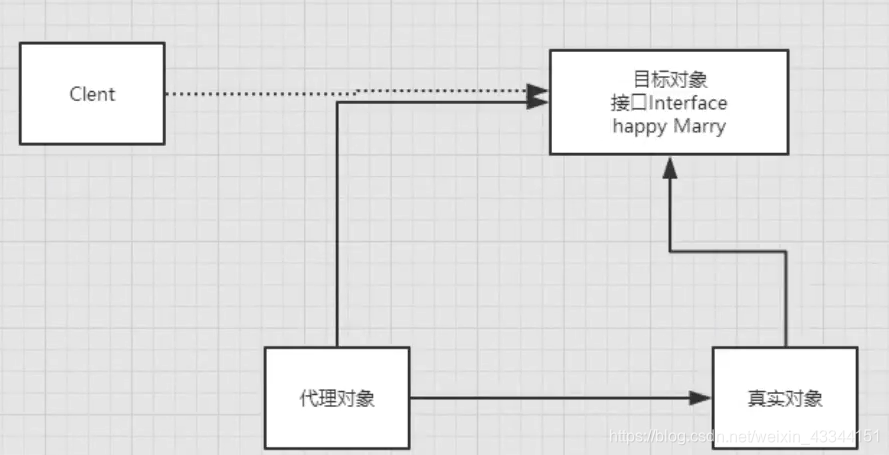
MyBatis详细执行流程
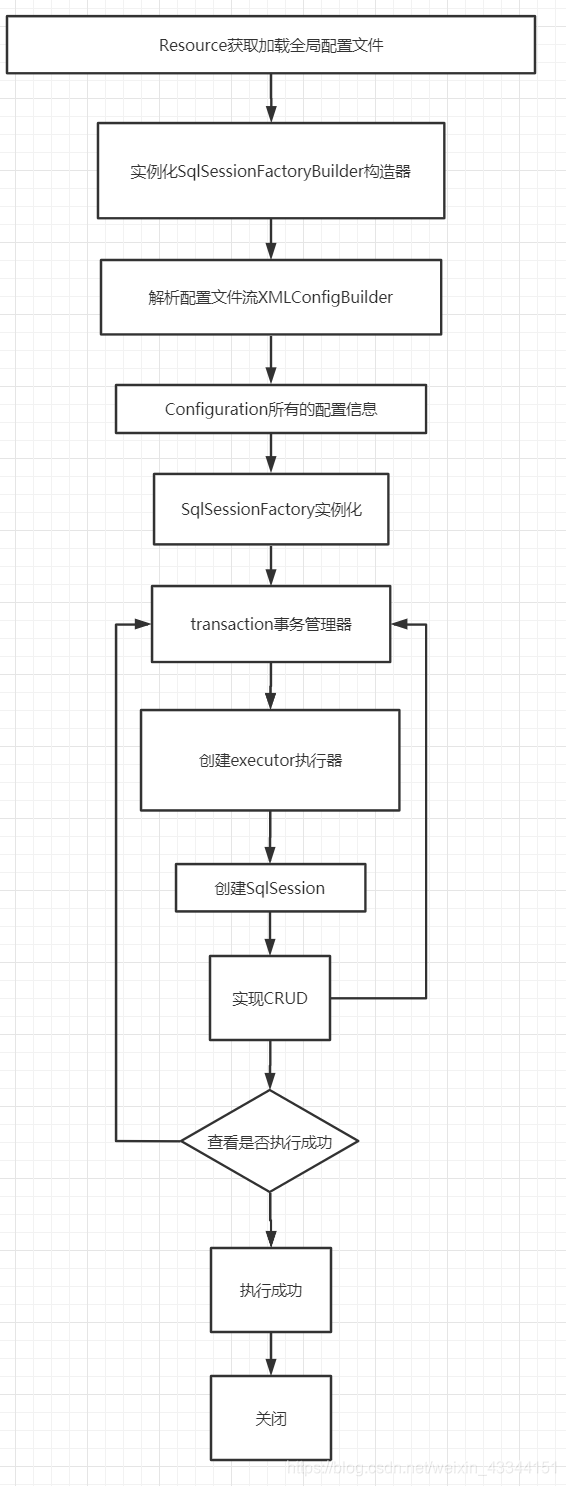
8.3 CRUD
我们可以在工具类创建的时候实现自动提交
public static SqlSession getSqlSession(){
return sqlSessionFactory.openSession(true);
}编写接口,增加注解
package cn.tedu.dao;
import cn.tedu.pojo.User;
import org.apache.ibatis.annotations.Delete;
import org.apache.ibatis.annotations.Insert;
import org.apache.ibatis.annotations.Param;
import org.apache.ibatis.annotations.Select;
import org.apache.ibatis.annotations.Update;
import java.util.List;
/**
* @ClassName UserMapper
* @Description
* @Author keke
* @Time 2021/5/30 15:04
* @Version 1.0
*/
public interface UserMapper {
@Select("select * from user")
List<User> getUsers();
/**
* 方法存在多个参数,所有的参数前面必须加上@Param注解
* @param id
* @return
*/
@Select("select * from user where id = #{id}")
User getUserById(@Param("id") int id);
@Insert("insert int user(id, name, pwd) values(#{id}, #{name}, #{password})")
int addUser(User user);
@Update("update user set name = #{name}, pwd = #{password} where id = #{id}")
int updateUser(User user);
@Delete("delete from user where id = #{uid}")
int deleteUser(@Param("uid") int id);
}测试类
【注意:我们必须要将接口注册绑定到核心配置文件中】
关于@Param注解
- 基本类型的参数或者String类型,需要加上
- 引用类型不需要加
- 如果只有一个基本类型的话,可以忽略,但是建议都加上
- 我们在SQL中引用的就是我们这里设定的属性名
#{}和${}区别
9 Lombok
Project Lombok is a java library that automatically plugs into your editor and build tools, spicing up your java. Never write another getter or equals method again, with one annotation your class has a fully featured builder, Automate your logging variables, and much more.
- java library
- plugs
- build tools
- with one annotation your class 使用步骤:
- 在idea中安装Lombok插件
- 在项目中导入lombok的jar包
<dependency>
<groupId>org.projectlombok</groupId>
<artifactId>lombok</artifactId>
<version>1.18.20</version>
</dependency>- 在实体类上加注解
@Data
@AllArgsConstructor
@NoArgsConstructor@Getter and @Setter
@FieldNameConstants
@ToString
@EqualsAndHashCode
@AllArgsConstructor, @RequiredArgsConstructor and @NoArgsConstructor
@Log, @Log4j, @Log4j2, @Slf4j, @XSlf4j, @CommonsLog, @JBossLog, @Flogger, @CustomLog
@Data
@Builder
@SuperBuilder
@Singular
@Delegate
@Value
@Accessors
@Wither
@With
@SneakyThrows说明:
@Data:无参构造、getter、setter、toString、hashCode、equals
@AllArgsConstructor
@NoArgsConstructor
@EqualsAndHashCode
@ToString
@Getter
@Setter10 多对一处理
多对一:
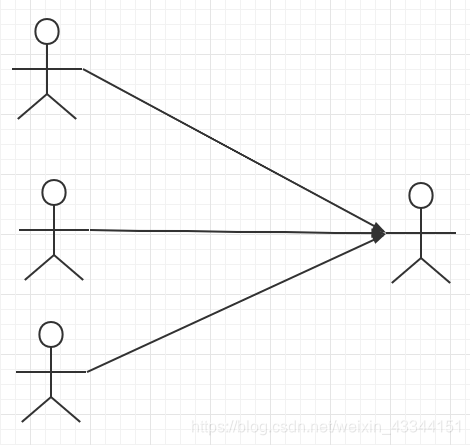
- 多个学生对应一个老师
- 对于学生这边而言,关联多个老师,关联一个老师【多对一】
- 对应老师而言,集合,一个老师有很多学生【一对多】
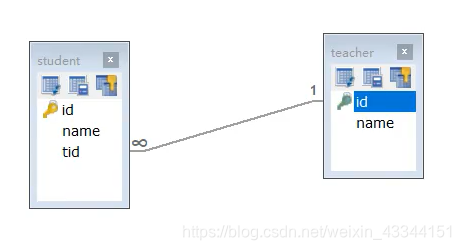
sql:
create table `teacher`(
`id` int(10) not null ,
`name` varchar(30) default null,
primary key (`id`)
)engine=INNODB default charset=utf8;
insert into `teacher`(`id`, `name`) values(1, '秦老师');
create table `student`(
`id` int(10) not null,
`name` varchar(30) default null,
`tid` int(10) default null,
primary key (`id`),
key `fktid`(`tid`),
constraint `fktid` foreign key (`tid`) references `teacher`(`id`)
)engine=INNODB default charset=utf8;
insert into `student`(`id`, `name`, `tid`)values (1, '小明', 1);
insert into `student`(`id`, `name`, `tid`)values (2, '小红', 1);
insert into `student`(`id`, `name`, `tid`)values (3, '小张', 1);
insert into `student`(`id`, `name`, `tid`)values (4, '小李', 1);
insert into `student`(`id`, `name`, `tid`)values (5, '小王', 1);10.1 测试环境搭建
- 导入lombok
- 新建实体类Teacher、Student
- 建立Mapper接口
- 建立Mapper.xml文件
- 在核心配置文件中绑定注册我们的Mapper接口或文件
- 测试查询是否成功
10.2 按照查询嵌套处理
<!--
思路:
1.查询所有的学生信息
2.根据查询出来的学生tid,寻找对应的老师
-->
<resultMap id="studentTeacher" type="Student">
<result property="id" column="id"/>
<result property="name" column="name"/>
<!--
复杂的属性我们需要单独处理
对象:association
集合:collection
-->
<association property="teacher" column="tid"
javaType="Teacher" select="getTeacher"/>
</resultMap>
<select id="getStudent" resultMap="studentTeacher">
select *
from student;
</select>
<select id="getTeacher" resultType="Teacher">
select *
from teacher
where id = #{id};
</select>10.3 按照结果嵌套处理
<!-- 2.按照结果嵌套处理 -->
<resultMap id="studentTeacher2" type="Student">
<result property="id" column="sid" />
<result property="name" column="sname" />
<association property="teacher" javaType="Teacher">
<result property="name" column="tname" />
</association>
</resultMap>
<select id="getStudent2" resultMap="studentTeacher2">
select s.id sid, s.name sname, t.name tname
from student s,
teacher t
where s.tid = t.id;
</select>回顾MySQL多对一查询方式:
- 子查询
- 联表查询
11 一对多
比如:一个老师拥有多个学生 对于老师而言,就是一对多的关系
11.1 环境搭建
- 环境搭建,和刚才一样 实体类
package cn.tedu.pojo;
import lombok.AllArgsConstructor;
import lombok.Data;
import lombok.NoArgsConstructor;
/**
* @ClassName Student
* @Description
* @Author keke
* @Time 2021/6/4 23:59
* @Version 1.0
*/
@Data
@AllArgsConstructor
@NoArgsConstructor
public class Student {
private int id;
private String name;
private int tid;
}package cn.tedu.pojo;
import lombok.AllArgsConstructor;
import lombok.Data;
import lombok.NoArgsConstructor;
import java.util.List;
/**
* @ClassName Teacher
* @Description
* @Author keke
* @Time 2021/6/5 0:00
* @Version 1.0
*/
@Data
@AllArgsConstructor
@NoArgsConstructor
public class Teacher {
private int id;
private String name;
/**
* 一个老师拥有多个学生
*/
private List<Student> students;
}11.2 按照查询嵌套处理
<select id="getTeacherStudent2" resultMap="teacherStudent2">
select *
from teacher
where id = #{tid};
</select>
<resultMap id="teacherStudent2" type="Teacher">
<collection property="students" javaType="ArrayList"
ofType="Student"
select="getStudentByTeacherId" column="id"/>
</resultMap>
<select id="getStudentByTeacherId" resultType="Student">
select *
from student
where tid = #{tid};
</select>11.3 按照结果嵌套处理
<!-- 按照结果嵌套查询-->
<select id="getTeacherStudent" resultMap="teacherStudent">
select s.id sid, s.name sname, t.name tname, t.id tid
from student s, teacher t
where s.tid = t.id and t.id = #{tid};
</select>
<resultMap id="teacherStudent" type="Teacher">
<result property="id" column="tid"/>
<result property="name" column="tname"/>
<!--
复杂的属性,我们需要单独获取
对象:association
集合:collection
javaType="":指定属性的类型
集合中的泛型信息,我们使用ofType获取
-->
<collection property="students" ofType="Student">
<result property="id" column="sid" />
<result property="name" column="sname" />
<result property="tid" column="tid" />
</collection>
</resultMap>**小结 **
- 关联-association【多对一】
- 集合-collection【一对多】
- javaType & ofType javaType:用来指定实体类中属性的类型 ofType:用来指定映射到List或者集合中的pojo类型,泛型中的约束类型
注意点:
- 保证SQL的可读性,尽量保证通俗易懂
- 注意一对多和多对一中,属性名和字段的问题
- 如果问题不好排除,可以使用日志,建议使用Log4J
慢SQL 1s 1000s
面试高频
- MySQL引擎
- InnoDB底层原理
- 索引
- 索引优化
12 动态SQL
什么是动态SQL:动态SQL就是根据不同的语句生成不同的SQL语句 利用动态 SQL,可以彻底摆脱这种痛苦。
如果你之前用过 JSTL 或任何基于类 XML 语言的文本处理器,你对动态 SQL 元素可能会感觉似曾相识。在 MyBatis 之前的版本中,需要花时间了解大量的元素。借助功能强大的基于 OGNL 的表达式,MyBatis 3 替换了之前的大部分元素,大大精简了元素种类,现在要学习的元素种类比原来的一半还要少。 if choose (when, otherwise) trim (where, set) foreach
12.1 搭建环境
create table `blog`(
`id` varchar(50) not null comment '博客id',
`title` varchar(100) not null comment '博客标题',
`author` varchar(30) not null comment '博客作者',
`create_time` datetime not null comment '创建时间',
`views` int(30) not null comment '游览量'
)engine=InnoDB default charset=utf8; 创建一个基础工程
- 导包
- 编写配置文件
- 编写实体类
package cn.tedu.pojo;
import lombok.AllArgsConstructor;
import lombok.Data;
import lombok.NoArgsConstructor;
import java.util.Date;
/**
* @ClassName Blog
* @Description
* @Author keke
* @Time 2021/6/5 15:06
* @Version 1.0
*/
@Data
@NoArgsConstructor
@AllArgsConstructor
public class Blog {
private String id;
private String title;
private String author;
private Date createTime;
private int views;
}- 编写实体类对应Mapper接口和Mapper.xml文件
12.2 if
<select id="queryBlogIf" parameterType="map" resultType="Blog">
select *
from blog
where 1=1
<if test="title != null">
and title = #{title}
</if>
<if test="author != null">
and author = #{author}
</if>;
</select>12.3 choose (when, otherwise)
<select id="queryBlogChoose" parameterType="map" resultType="Blog">
select *
from blog
<where>
<choose>
<when test="title != null">
title = #{title}
</when>
<when test="author != null">
and author = #{author}
</when>
<otherwise>
and views = #{views}
</otherwise>
</choose>
</where>
</select>12.4 trim(where, set)
select *
from blog
<where>
<if test="title != null">
title = #{title}
</if>
<if test="author != null">
and author = #{author}
</if>
</where><update id="updateBlog" parameterType="map">
update blog
<set>
<if test="title != null">
title = #{title},
</if>
<if test="author != null">
author = #{author},
</if>
</set>
where id = #{id}
</update>所谓的动态SQL,本质还是SQL语句,只是我们可以在SQL聪明,去执行一些逻辑代码
12.5 SQL片段
有的时候,我们可能会将一些功能的公共部分抽取出来,进行复用
- 使用SQL标签抽取公共部分
<sql id="if-title-author">
<if test="title != null">
title = #{title}
</if>
<if test="author != null">
and author = #{author}
</if>
</sql>- 在需要使用的地方使用include标签引用即可
<select id="queryBlogIf" parameterType="map" resultType="Blog">
select *
from blog
<where>
<include refid="if-title-author"/>
</where>
</select>注意事项:
- 最好基于单表定义SQL片段
- 不要存在where标签
12.6 forEach
select * from user where 1 = 1 and (id = 1 or id = 2 or id = 3);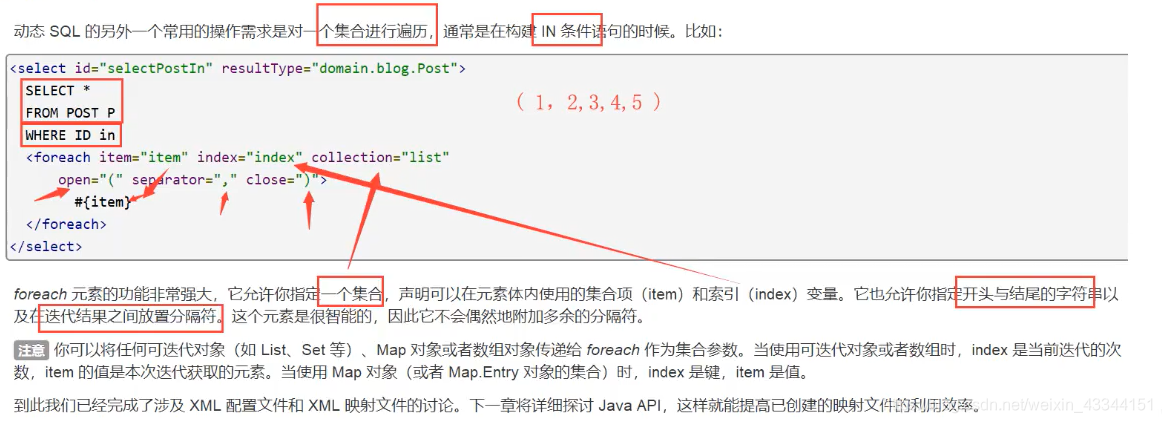
<!--
我们现在传递万能map,这map中可以存在一个集合
-->
<select id="queryBlogForeach" parameterType="map" resultType="Blog">
select *
from blog
<where>
<foreach collection="ids" item="id" open="and (" close=")" separator="or">
id = #{id}
</foreach>
</where>
</select>动态SQL就是在拼接SQL语句,我们只有保证SQL的正确性,去排列组合就可以了
建议: 先在mysql中写出完整SQL,再对应的去修改成为我们的动态SQL实现通用即可
13 缓存
13.1 简介
查询: 连接数据库,耗资源
一次查询的结果给它暂存在一个可以直接取到的地方 --> 内存:缓存
我们再次查询相同数据的时候,直接走缓存,不用走数据库- 什么是缓存[ Cache ]?
- 存在内存中的临时数据。
- 将用户经常查询的数据放在缓存(内存)中,用户去查询数据就不用从磁盘上(关系型数据库数据文件)查询,从缓存中查询,从而提高查询效率,解决了高并发系统的性能问题。
- 为什么使用缓存?
- 减少和数据库的交互次数,减少系统开销,提高系统效率。
- 什么样的数据能使用缓存?
- 经常查询并且不经常改变的数据。【可以使用缓存】
13.2 Mybatis缓存
- MyBatis包含一个非常强大的查询缓存特性,它可以非常方便地定制和配置缓存。缓存可以极大的提升查询效率。
- MyBatis系统中默认定义了两级缓存:一级缓存和二级缓存
- 默认情况下,只有一级缓存开启。(SqlSession级别的缓存,也称为本地缓存)。二级缓存需要手动开启和配置,他是基于namespace级别的缓存。
- 为了提高扩展性,MyBatis定义了缓存接口Cache。我们可以通过实现Cache接口来自定义二级缓存
13.3 一级缓存
- 一级缓存也叫本地缓存
- 与数据库同一次会话期间查询到的数据会放在本地缓存中。
- 以后如果需要获取相同的数据,直接从缓存中拿,没必须再去查询数据库; 测试步骤:
- 开启日志
- 测试在一个Session中查询两次相同记录
- 查看日志输出
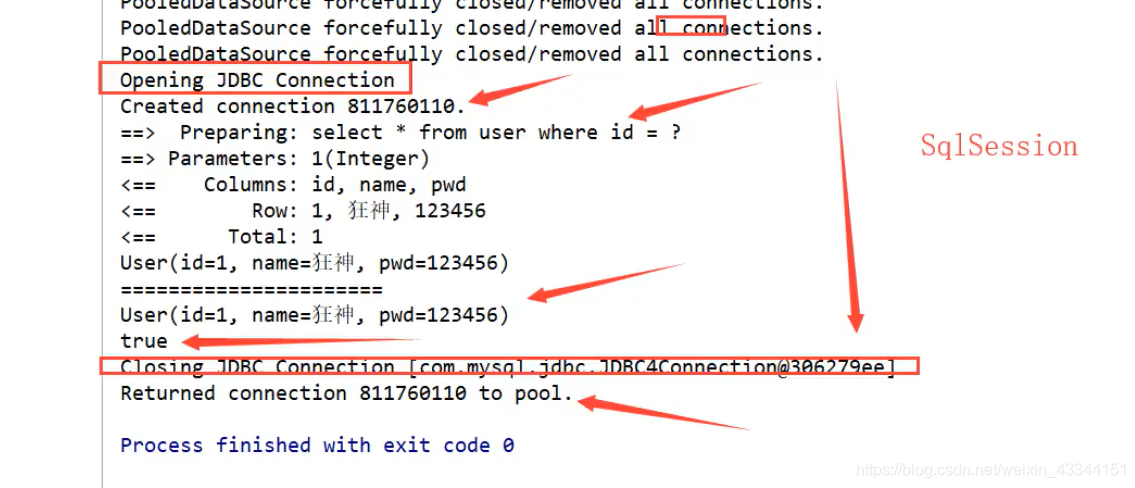
缓存失效的情况:
- 查询不同的东西
- 增删改操作,可能会改变原来的数据,所以必定会刷新缓存
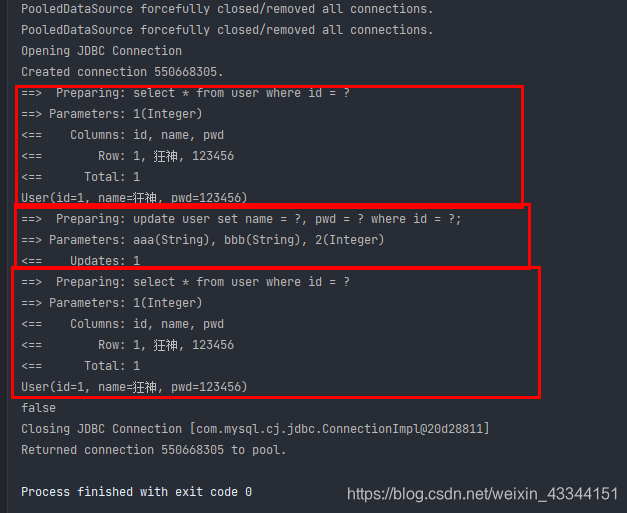
- 查询不同的Mapper.xml
- 手动清理缓存
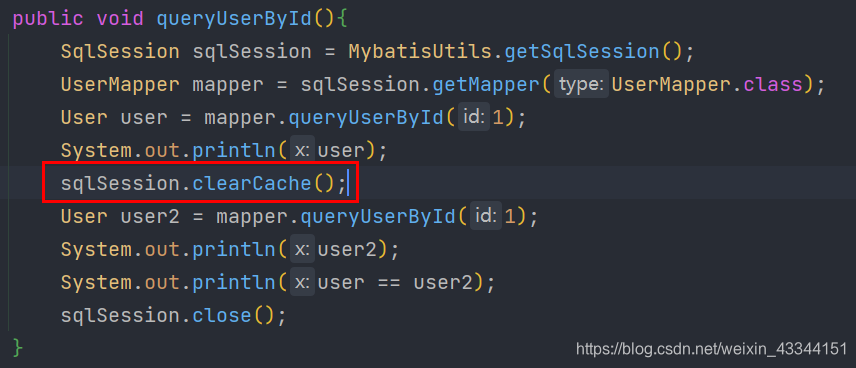
小结:一级缓存默认是开启的,只在一次SqlSession中有效,也就是拿到连接到关闭连接这个区间段 一级缓存就是一个Map
13.4 二级缓存
- 二级缓存也叫全局缓存,一级缓存作用域太低了,所以诞生了二级缓存
- 基于namespace级别的缓存,一个名称空间,对应一个二级缓存;
- 工作机制
- 一个会话查询一条数据,这个数据就会被放在当前会话的一级缓存中;
- 如果当前会话关闭了,这个会话对应的一级缓存就没了;但是我们想要的是,会话关闭了,一级缓存中的数据被保存到二级缓存中;
- 新的会话查询信息,就可以从二级缓存中获取内容;
- 不同的mapper查出的数据会放在自己对应的缓存(map)中; 步骤:
- 开启全局缓存
<!-- 显示开启全局缓存 -->
<setting name="cacheEnabled" value="true"/>- 在要使用二级缓存的mapper中开启
<!-- 在当前mapper.xml中使用二级缓存 -->
<cache/>也可以自定义参数
<!-- 在当前mapper.xml中使用二级缓存 -->
<cache eviction="FIFO"
flushInterval="60000"
size="512"
readOnly="true"/>- 测试
问题:我们需要将实体类序列化,否则就会报错
Caused by: java.io.NotSerializableException: cn.tedu.pojo.User小结:
- 只要开启了二级缓存,在同一个mapper下就有效
- 所有的数据都会先放在一级缓存中
- 只有当会话提交,或者关闭的时候,才会提交到二级缓存中
13.5 缓存原理
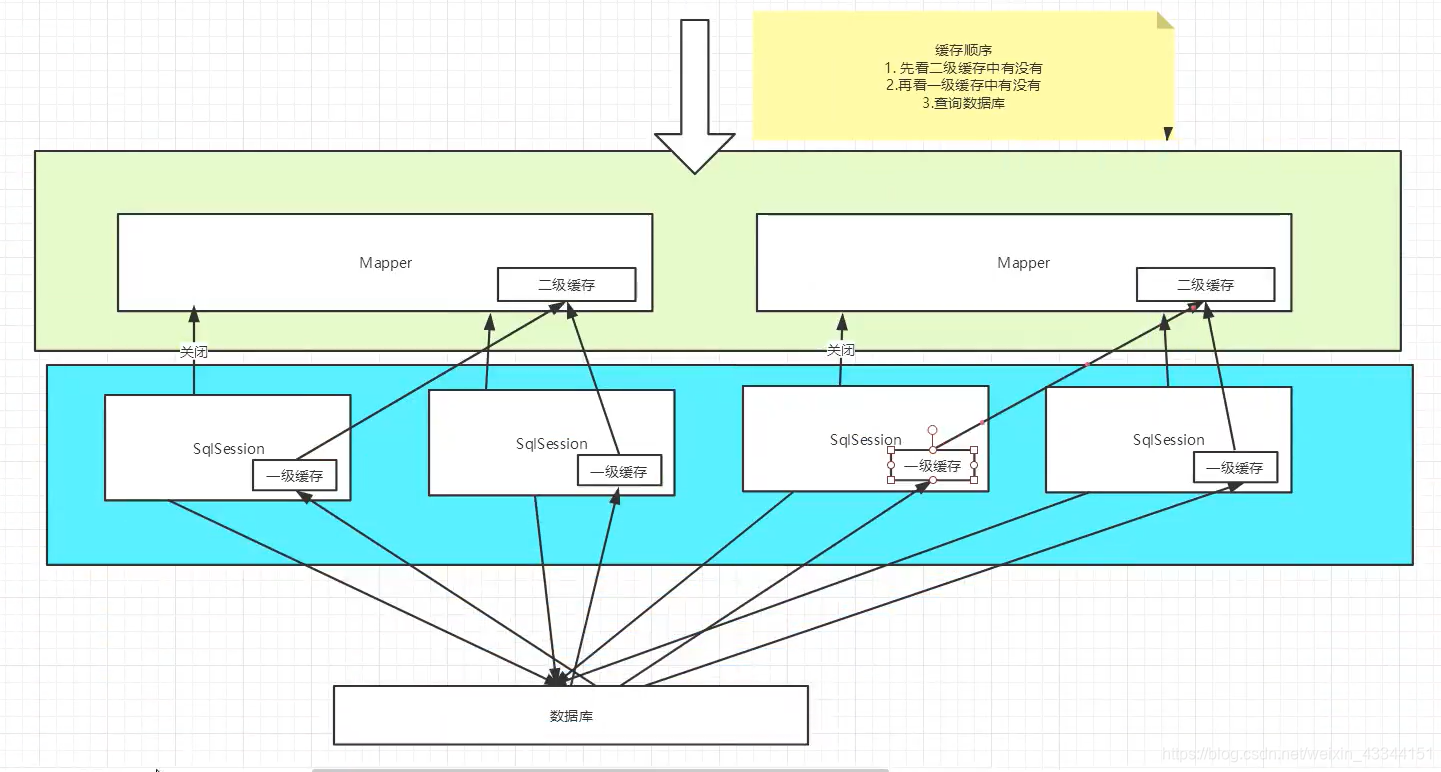
13.6 自定义缓存-ehcache
Ehcache是一种广泛使用的开源Java分布式缓存。主要面向通用缓存,Java EE和轻量级容器。
要在程序中使用,先要导包
<dependency>
<groupId>org.mybatis.caches</groupId>
<artifactId>mybatis-ehcache</artifactId>
<version>1.1.0</version>
</dependency>在mapper中指定使用我们的ehcache缓存实现
<!-- 在当前mapper.xml中使用二级缓存 -->
<cache type="org.mybatis.caches.ehcache.EhcacheCache"/>ehcache.xml
<?xml version="1.0" encoding="UTF-8"?>
<ehcache xmlns:xsi="http://www.w3.org/2001/XMLSchema-instance"
xsi:noNamespaceSchemaLocation="http://ehcache.org/ehcache.xsd"
updateCheck="false">
<!--
diskStore:为缓存路径,ehcache分为内存和磁盘两级,此属性定义磁盘的缓存位置。参数解释如下:
user.home – 用户主目录
user.dir – 用户当前工作目录
java.io.tmpdir – 默认临时文件路径
-->
<diskStore path="./tmpdir/Tmp_EhCache"/>
<!--
defaultCache:默认缓存策略,当ehcache找不到定义的缓存时,则使用这个缓存策略。只能定义一个。
-->
<!--
name:缓存名称。
maxElementsInMemory:缓存最大数目
maxElementsOnDisk:硬盘最大缓存个数。
eternal:对象是否永久有效,一但设置了,timeout将不起作用。
overflowToDisk:是否保存到磁盘,当系统宕机时
timeToIdleSeconds:设置对象在失效前的允许闲置时间(单位:秒)。仅当eternal=false对象不是永久有效时使用,可选属性,默认值是0,也就是可闲置时间无穷大。
timeToLiveSeconds:设置对象在失效前允许存活时间(单位:秒)。最大时间介于创建时间和失效时间之间。仅当eternal=false对象不是永久有效时使用,默认是0.,也就是对象存活时间无穷大。
diskPersistent:是否缓存虚拟机重启期数据 Whether the disk store persists between restarts of the Virtual Machine. The default value is false.
diskSpoolBufferSizeMB:这个参数设置DiskStore(磁盘缓存)的缓存区大小。默认是30MB。每个Cache都应该有自己的一个缓冲区。
diskExpiryThreadIntervalSeconds:磁盘失效线程运行时间间隔,默认是120秒。
memoryStoreEvictionPolicy:当达到maxElementsInMemory限制时,Ehcache将会根据指定的策略去清理内存。默认策略是LRU(最近最少使用)。你可以设置为FIFO(先进先出)或是LFU(较少使用)。
clearOnFlush:内存数量最大时是否清除。
memoryStoreEvictionPolicy:可选策略有:LRU(最近最少使用,默认策略)、FIFO(先进先出)、LFU(最少访问次数)。
FIFO,first in first out,这个是大家最熟的,先进先出。
LFU, Less Frequently Used,就是上面例子中使用的策略,直白一点就是讲一直以来最少被使用的。如上面所讲,缓存的元素有一个hit属性,hit值最小的将会被清出缓存。
LRU,Least Recently Used,最近最少使用的,缓存的元素有一个时间戳,当缓存容量满了,而又需要腾出地方来缓存新的元素的时候,那么现有缓存元素中时间戳离当前时间最远的元素将被清出缓存。
-->
<defaultCache
eternal="false"
maxElementsInMemory="10000"
overflowToDisk="false"
diskPersistent="false"
timeToIdleSeconds="1800"
timeToLiveSeconds="259200"
memoryStoreEvictionPolicy="LRU"/>
<cache
name="cloud_user"
eternal="false"
maxElementsInMemory="5000"
overflowToDisk="false"
diskPersistent="false"
timeToIdleSeconds="1800"
timeToLiveSeconds="1800"
memoryStoreEvictionPolicy="LRU"/>
</ehcache>
